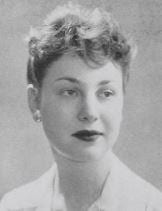Abstract
In this 2018 interview, Beverly Adele Moss, Pembroke College class of 1945, discusses her family upbringing, time at Pembroke College during World War II, and subsequent career. A trailblazing woman for her time, Moss discusses her experience serving on planning and preservation commissions in New York City, and thusly how Pembroke was an influential grounding.
The first part of the interview focuses on Moss’ early life growing up in Brooklyn, New York. She discusses her close relationship with her parents, specifically their support of her education. Her mother volunteered for the notable anthropologist, Margaret Mead, while her father was a partner at a law firm, served as President of the New York City Board of Education (1949-1950), and was an important philanthropic figure in the community. Moss’ older siblings both attended Pembroke and Brown, and after graduating from James Madison High School in New York, Moss decided to attend Pembroke as well. While discussing her childhood, Moss also notes how the Great Depression affected her family and her friends.
Beginning her college degree in 1941, Moss communicates the climate on campus during WWII and the relief efforts in which the students were involved. She was a part of a group on campus responsible for wartime safety. Moss also recalls various memories of Pembroke, including living in Metcalf dorm and her involvement with the Jewish community on campus. She says that at the time, there was religious diversity amongst the students. She fondly reminisces about deans and faculty whom she was close to, as well as her peers.
After graduating, Moss joined the League of Women Voters and worked for the Abraham and Strauss department store as a photographer. Later on, she worked at a label corporation as an engraver. During this era, Moss met her husband, Dr. Samual Spatt, who was a flight surgeon and later a physician, through a mutual friend. Moss describes their meeting as “love at first sight.” They remained together until his death 61 years later.
Shortly after marrying, Moss had her first child and she talks about how difficult early motherhood was for her. Beverly and Samuel would go on to have three children and three grandchildren together.
Later in the interview, Moss describes her relationship to feminism at the time, as well as the transition of her focus from the League of Women Voters to her career in city planning and preservation. Moss was active in many city groups in Brooklyn, including the Citizen Union. It was during this era that Mayor Robert Wagner appointed Moss to be Chair of the New York City Planning Commission in 1965. She recalls various projects with the commission – especially her dissension of the New York City Plan – her professional relationship with Robert Moses, and her views on high-density housing and real estate. She worked on the planning commission until 1970 when Mayor John Lindsey chose not to reappoint her. However, she was later appointed to chair the Landmarks Preservation Commission in 1974. Moss then talks about the difficulty of losing her position on the City Landmarks Preservation Commission in 1982.
Towards the end of the interview, Moss discusses her shift from working in landmarks and preservation to her position with a progressive bishop in Brooklyn named Joseph Sullivan. She worked as his assistant and speechwriter for 25 years. Moss also mentions her relationship with Catholicism, despite her Jewish background and identity. Moss ends the interview talking about her motivations of inclusiveness, justice, equality, and reason that drove her life and career.
Recorded on April 11, 2018 in New York, NY
Interviewed by Mary Murphy, Nancy L. Buc ’65 LLD‘94 hon Pembroke Center Archivist
Suggested Chicago style citation: Moss, Beverly Adele. Interview. By Mary Murphy. Pembroke Center Oral History Project, Brown University. April 11, 2018.
Biography
Beverly Adele Moss was born in Brooklyn, New York to Maximillian and Grace Moss. Her father was an attorney and the President of the New York City Board of Education, as well as an important philanthropic figure in Brooklyn. Her mother was a volunteer for the notable anthropologist, Margaret Mead. Moss attended James Madison High School high school in Brooklyn, with a brief period at boarding school in the south, and then went on to get her Bachelors degree at Pembroke College, where she graduated cum laude in 1945. After graduation, Moss met her husband, Samuel Spatt, who was a flight surgeon during World War II and later an internist physician. They had three children in quick succession: Robin, Jonathan, and David. After 61 years of marriage, Moss’ husband passed away from heart failure. Moss remains in her family’s home in Brooklyn at almost 94 years of age.
Throughout her career, Moss held several high-profile positions for the city of New York. A faithful member to the League of Women Voters, she was civically active right out of college, and after a few smaller positions in the city, Moss joined the New York City Planning Commission in 1965. She famously dissented on several major projects throughout New York during her time on the commission until 1970. In 1974, Moss was appointed to the Landmarks Preservation Commission as chair until 1978, and she remained a member until 1982. There her goal was to be transparent, nonpolitical, and she was able to persuade the mayor to appeal the Grand Central decision. She also saved Vuillard houses, and she gained private and public funding for over sixteen new programs including the Landmarks Scholar Program.
During the interim of her positions in these commissions, Moss also taught planning, preservation, public policy, housing, and community advocacy at the New School for Social Research (1967-1970) and Barnard College (1970-1983). Towards the end of her career, Moss worked for Bishop Joseph Sullivan as an assistant and speechwriter until 2013.
